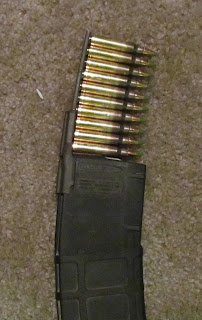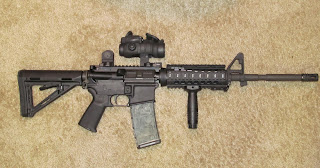One topic that people seem to confuse on a rather regular basis is what is a magazine, and what is a clip. In the picture above there are both magazines, and clips. First are the four magazines, starting from the left, a 30 round AK-variant magazine, a 30 round Magpul Pmag for 5.56 rifles, a 15 round Sig 226 9mm magazine, and a 6 round .45 ACP Glock 36 magazine. On the right side are two clips, a stripper clip holding 10 5.56x45 cartridges, and a 5 round stripper clip holding 7.62x54R for Mosin Nagant rifles. When looking at the two groups above, it is easy to see that there are some differences between magazines and clips.
So, what are the functions of each respectively? The four detachable box magazines are used to hold ammunition in a semi-automatic firearm, and able to be quickly replaced. They are inserted into the magazine well, and remain in place while operating the firearm. The clips, on the other hand, are used to reload magazines. The Mosin Nagant rifle, and the vast majority of other bolt action rifles, have non-detachable box magazines. This means that they are internal to the rifle, and are usually loaded through the top of the action, with the bolt pulled to the rear. Instead of having soldiers try to load loose rounds by hand in the heat of battle, most military bolt action rifles had the ability to be loaded with stripper clips. The bolt was pulled to the rear, the clip placed into some guides cut into the receiver, and then the rounds pushed down into the magazine.
Stripper clips can also be used to reload detachable box magazines. As you can see in the picture above, there are metal stripper clip guides that can be placed onto magazines. Then you insert the stripper clips into the guide, and simply push the bullets down into the magazine. Loading a 30 round AR-style rifle magazine with 3 stripper clips is a whole lot easier and faster than loading 30 loose rounds by hand.
Magazines really are rather simple mechanical devices, but the picture above shows the components, which are common for either pistol or rifle magazines. There is the magazine body, a piece of metal or plastic formed to hold the rest of the components. The magazine follower, which is the usually plastic piece on top of the spring, which is that the last round in the mag pushes against. The spring itself, which may or may not have a plate on the bottom to help keep it level and from binding, and the base-plate.
Even though they are so simple, there are a number of things that can cause a magazine to malfunction. In semi-automatic firearms, a very high percentage of malfunctions are magazine related. The springs can go bad with use over time, thankfully that is usually very easy and cheap to fix. The P-mag follower above is an anti-tilt follower, which is why it has the two long pieces of plastic on the sides. This keeps the follower level while in use, and keeps it from binding, preventing proper feeding. Not all magazines have that characteristic, so whenever possible, it is desirable to get magazines that do. For some magazines you can also buy aftermarket anti-tilt followers. Also, the feed lips which hold the rounds in the magazine at the top, and allow the bullet to line up with the bolt and chamber, can over time spread out due to the constant pressure on them, which can allow double feeds and other malfunctions to happen. Also the base plate can become damaged, and allow the spring and bullets to fall out of the bottom of the magazine, although that is fairly uncommon, unless the magazine suffers a hard impact, like being thrown on concrete.
Hopefully this clears up some of the confusion on the magazine vs clip dilemma, and provided some basic knowledge about one of the important aspects of semi-automatic firearms. Next time you think about asking someone to hand you a clip, remember the picture below.






